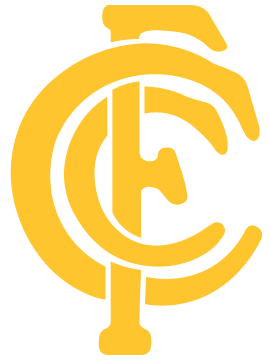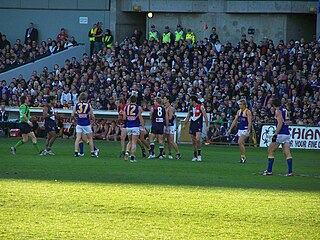
The West Australian Football League is an Australian rules football league based in Perth, Western Australia. The league currently consists of ten teams, which play each other in a 20-round season usually lasting from April to September, with the top five teams playing off in a finals series, culminating in a Grand Final. The league also runs reserves, colts (under-19) and women's competitions.
Subiaco Oval was a sports stadium in Perth, Western Australia, located in the suburb of Subiaco. It was opened in 1908 and closed in 2017 after the completion of the new Perth Stadium in Burswood.

The Claremont Football Club, nicknamed Tigers, is an Australian rules football club based in Claremont, Western Australia, that currently plays in the West Australian Football League (WAFL) and WAFL Women's (WAFLW). Its official colours are navy blue and gold. Formed as the "Cottesloe Beach Football Club" in 1906, the club entering the WAFL in 1925 as the "Claremont-Cottesloe Football Club"', changing its name to the present in 1935. Claremont have won 12 senior men's premierships since entering the competition, including most recently the 2011 and 2012 premierships.

The East Perth Football Club, nicknamed the Royals, is an Australian rules football club based in Leederville, Western Australia, current playing in the West Australian Football League (WAFL). Formed in 1902 as the Union Football Club, the club entered the WAFL in 1906, changing its name to East Perth. It won its first premiership in 1919, part of a streak of five consecutive premierships. Overall, the club has won 17 premierships, most recently in 2002. The club is currently based at Leederville Oval, which it shares with the Subiaco Football Club, having previously played home games at Wellington Square and Perth Oval from 1910 to 1999.

The Subiaco Football Club, nicknamed the Lions and known before 1973 as the Maroons, is an Australian rules football club in the West Australian Football League (WAFL) and WAFL Women's (WAFLW). It was founded in 1896, and admitted to the WAFL in 1901, along with North Fremantle. The club is currently based at Leederville Oval, having previously played at Subiaco Oval.

Australian rules football is the most popular sport in Western Australia (WA). There are 29 regional club competitions, the highest profile of which is the semi-professional West Australian Football League. It is governed by the West Australian Football Commission (WAFC). With more than 95,000 registered adult players, it has the second largest of any jurisdiction, accounting for almost a fifth of players nationally and growing faster than any other state.

Claremont Oval, also known by naming rights sponsorship as Revo Fitness Stadium, is an Australian rules football stadium located in Perth, Western Australia. The stadium, opened in 1905 as "Claremont Recreation Ground", seats 5,000. It is the home of the Claremont Football Club, an Australian rules football club that plays in the Western Australian Football League (WAFL), the state's premier Australian rules competition.

Perth Stadium, currently known as Optus Stadium due to sponsorship reasons, is a multi-purpose stadium in Perth, Western Australia, located in the suburb of Burswood. It was completed in late 2017 and officially opened on 21 January 2018. The stadium's total capacity is 61,266, including standing room, making it the third-largest stadium in Australia. The stadium can be extended up to 65,000 seats for rectangular sports.
The 1983 WAFL season was the 99th season of the West Australian Football League in its various incarnations. The season opened on 31 March and concluded on 17 September with the 1983 WAFL Grand Final contested between Claremont and Swan Districts.
The 1930 WAFL season was the 46th season of the West Australian Football League in its various incarnations, and the last before it changed its name to the ‘Western Australian National Football League’. The season saw East Fremantle win the premiership for the third consecutive season, marking the second time that the club had achieved the feat; the club was never seriously challenged as the best team except during the interstate break and achieved the unusual feat of being the only club with a percentage of over 100.[a] Jerry Dolan said in retrospect that East Fremantle's 1930 team was the greatest he had ever played in or coached – including even the unbeaten team of 1946.
The 1937 WANFL season was the 53rd season of the Western Australian National Football League. The season saw numerous notable highlights, including:
- Five players[a] kicked 100 goals, a number equalled in the major leagues of VFL/AFL, VFA/VFL, or SANFL, only in the 1939 VFA season.[b]
- Frank "Scranno" Jenkins won the Sandover Medal in his debut season of senior football with a record high under the 3-2-1 voting system of 34 votes.
- In the second round, East Fremantle broke their own 21-year-old record for the highest score in league history.
- East Perth drew three games in one season, a feat equalled in major Australian Rules Leagues only by VFA club Moorabbin in 1958 and West Perth in 1960. The Royals could easily have drawn a fourth game but for crowd acclamation preventing umpires from hearing the bell against Subiaco on Foundation Day. No senior Australian Rules team at any level is known to have tied four matches in a season, but Geelong’s Under-19s did so in 1971.
- Swan Districts, with Ted Holdsworth kicking at least six goals in each of the first ten games, reached their first finals series in only their fourth WANFL season. Holdsworth was to reach his 100 goals in two fewer games than George Doig took in his 152-goal 1934 season, but concussion and a broken hand eliminated the prospect of a new record.
The 1927 WAFL season was the 43rd season of the West Australian Football League. It saw the last premiership of the East Perth dynasty dating back to the end of World War I, as mastermind coach Phil Matson was to be killed in a truck crash the following year and the Royals were to fall to a clear last in 1929 as most of their champions retired. Despite opening their permanent home ground at Claremont Oval, newcomers Claremont-Cottesloe showed little improvement on their debut season and again won only a single game. The most notable change in fortunes was from South Fremantle, who had their first season with more wins than losses since their last premiership in 1917, and extended Matson's Royals in the grand final.
The 2007 WAFL season was the 123rd season of the various incarnations of the West Australian Football League. The season saw Subiaco, confounding the critics who expected them to slip after winning their second premiership in three years, win their second consecutive premiership for the first time in ninety-four seasons, with injury-plagued forward Brad Smith overcoming two reconstructions that wiped out 2005 and 2006 to kick 126 goals for the season, the most in the WAFL since Warren Ralph kicked 128 for Claremont in 1983. Smith also achieved the unique feat for a full-forward of winning the Simpson Medal in the Grand Final.
The 1926 WAFL season was the 42nd season of senior football in Perth, Western Australia.
The 1939 WANFL season was the 55th season of the various incarnations of the Western Australian National Football League. It is best known for West Perth's record losing streak of twenty-seven matches up to the fifteenth round, an ignominy equalled by Peel Thunder in their formative years but never actually beaten. The Cardinals finished with the worst record since Midland Junction lost all twelve games in 1917, and were the first WANFL team with only one victory for twelve seasons. In their only win, champion forward Ted Tyson became the first West Australian to kick over one thousand goals and he just failed to replicate his 1938 feat of leading the goalkicking for a bottom club. Subiaco, despite a second Sandover win from Haydn Bunton won only three matches, and Swan Districts, affected by the loss of star goalkicker Ted Holdsworth to Kalgoorlie, began a long period as a cellar-dweller with a fall to sixth.
The 1940 WANFL season was the 56th season of the various incarnations of the Western Australian National Football League. It saw Claremont win its third consecutive premiership, but its last before returning to the status of cellar-dweller it occupied during its first decade in the WA(N)FL – between 1943 and 1978 Claremont played finals only five times for one premiership. South Fremantle, after a lean period in the middle 1930s, displaced perennial power clubs East Fremantle and East Perth as the Tigers’ Grand Final opponent, and established some of the basis, in spite of three disastrous wartime under-age seasons, for the club's fabled dynasty after the war.
The 1941 WANFL season was the 57th season of the various incarnations of the Western Australian National Football League. Owing to the drain of players to military service in World War II, the league was forced to suspend the reserves competition until 1946, and ultimately this was to be the last season of senior football in Perth until 1945 as the supply of available players became smaller and smaller and the Japanese military threatened northern Western Australia.
The 1922 WAFL season was the 38th season of the West Australian Football League. It saw East Perth equal East Fremantle's feat of winning four consecutive premierships, this time against a rejuvenated West Perth team which had a lean period since 1912. Their most notable feat during the season was a record comeback against South Fremantle, but on an August tour of the Eastern States the Royals also defeated SANFL premiers Norwood by the score of 8.20 (68) to 7.10 (52) and runners-up West Adelaide by 11.12 (78) to 7.12 (54), after having lost by a point to St. Kilda two weeks beforehand. A consequence of their trip – hastily planned when Subiaco's tour there was cancelled during July – was that their last round match with wooden-spooner Perth was never played – a cancellation to be repeated the following season.
The 2022 WAFL season is the 138th season of the various incarnations of the West Australian Football League (WAFL).The season commenced on the 15th of April, and concluded with the Grand Final on the 1st of October, with West Perth defeating Claremont at Leederville Oval by 12 points. Fixtures were released in stages, to allow for COVID flexibility. The first stage saw the first nine rounds of the season be released, rounds 10-14 were released before the start of Round 7, and the final rounds (14-20) were released on July 8, before the start of Round 12. All the teams from the previous season have been retained, as there was speculation if the West Coast Eagles reserves would return.






